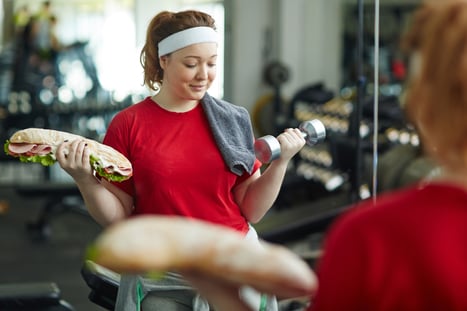The Transtheoretical Model (TTM) takes place every day in everyone’s life. It’s up to you, though, to move up the ladder on that model and make a healthy lifestyle change. The TTM is based on six stages. There is another stage that doesn’t appear on the model that people talk about, but we’ll get to that later.
The stages of the TTM in order are the following.
 Precontemplation
Precontemplation
This stage is where someone doesn’t see themselves changing within the next six months. Nothing will motivate the individual to become healthy at this point. This becomes a problem because some of these people are underinformed or not informed of what risk factors they are carrying. These people are just unmotivated and very resistant about talking or doing anything else that will essentially help increase their quality of life.
Contemplation
Contemplation is where individuals are ready to start exercising and realize that they need to make a change in their habits. These people want to take charge of the situation within the next six months because they understand the benefits of healthy living and that they need to decrease their risk factors in order to increase their quality of life. With that said, people start to do some research to figure out the costs involved in becoming healthy. A fair amount of people tend to stay in this stage due to the costs involved. These people are individuals who don’t have a lot of money to spare. So people tend to get stuck and go into what is called chronic contemplation.
Preparation
Preparation is the stage in which people will be ready to start making a change within a month. These people are individuals who have purchased workout equipment, joined a gym, talked to or made an appointment with their physician, and have bought other necessary essentials to get off to a great start. These individuals are very serious about change and take the right steps to be well prepared for it.
Action
The action stage is where people have made several changes to their lifestyle within the last six months that have significantly reduced the risks of disease. This stage is one of the most important stages because six months can determine whether an individual wants to achieve more, or it can be that breaking point in which that person decides to quit altogether. This is known as relapse.
Relapse
Relapse is a stage that anyone could hit. People will stop what they’re trying to achieve because their mindset is that they’re missing what they used to have, and what they’re doing is taking up too much time or is becoming difficult. In this case, exercising got too hard to complete. This usually happens within the first three months.
I myself have seen this occur when something unfortunate happens in someone’s life. These unfortunate events include loss of a job, loss of a loved one, not enough time in the day, exercise is not motivating anymore, and so on. Of course those things make you unmotivated to do anything. I get it, but when quitting anything, there are consequences. When losing a job, you’re out of a job and have no income. With no motivation, you tend to eat more and exercise less. Relapse can also happen after the maintenance stage. Someone might just want to take a break after getting into great shape, and then they’ll slowly go back to where they started.
Maintenance
Maintenance is where people have made a lot of changes in their lifestyle and are working even harder to maintain what they’ve been doing so that they don’t end up relapsing. People in the action stage are far more likely to relapse than someone in maintenance. The maintenance phase can last an estimated six months to five years. What people tend to do within that time is build up more confidence in order to make sure they are consistent with exercise and keeping away from poor habits. So although the action stage is the more likely time for someone to relapse, it’s still important for people to realize that a single craving and action to cater to that craving is more likely to happen at 12 months rather than five years.
Termination
This stage is a good stage in which to be. Termination is where someone is 100 percent into what they are doing and they don’t want to change because of the benefits of what they’re getting out of their choices in life. They are driven and confident individuals who don’t want to go back to what they once had where nothing motivated them (the Precontemplation stage).
***
It’s up to you what you want to do with your life, but remember that one decision can change everything. Make your weaknesses strengths, get involved in your community, exercise with a friend or spouse to help you stay motivated, and talk to your doctor, a counselor and a personal trainer to help get you on the right track to a better life.
Start the New Year right and set some goals and get started!




 One of the most overlooked factors of physical fitness is balance. This is especially important for the senior population, but balance is something every age group should think about. Balance is important in order to remain upright and steady when sitting up, standing, and walking. We utilize balance constantly in our daily routines without even thinking about it.
One of the most overlooked factors of physical fitness is balance. This is especially important for the senior population, but balance is something every age group should think about. Balance is important in order to remain upright and steady when sitting up, standing, and walking. We utilize balance constantly in our daily routines without even thinking about it.
 Joint pain is a very common problem, and keeping fit is one of the best ways to find reliable relief. For many of us, limiting activity might seem to make sense when a joint is achy. However, inactivity can make matters worse. In fact, inactivity is a leading cause of joint pain, causing weakness in muscles and bones that can lead to injuries and joint disorders like osteoarthritis.
Joint pain is a very common problem, and keeping fit is one of the best ways to find reliable relief. For many of us, limiting activity might seem to make sense when a joint is achy. However, inactivity can make matters worse. In fact, inactivity is a leading cause of joint pain, causing weakness in muscles and bones that can lead to injuries and joint disorders like osteoarthritis. If you are new to group fitness, or new to the
If you are new to group fitness, or new to the  This past Tuesday, January 8,
This past Tuesday, January 8,  Bodycombat is for everyone at a moderate-intermediate fitness level, and the moves are simple so little coordination is required! When you attend a regular Bodycombat class, you should expect to be led by your instructor through the martial arts moves drawn from various disciplines such as karate, taekwondo, tai chi, and muy thai while moving to the beat of heart pounding music. At the end of the class, you will feel strong, empowered, and slightly invincible.
Bodycombat is for everyone at a moderate-intermediate fitness level, and the moves are simple so little coordination is required! When you attend a regular Bodycombat class, you should expect to be led by your instructor through the martial arts moves drawn from various disciplines such as karate, taekwondo, tai chi, and muy thai while moving to the beat of heart pounding music. At the end of the class, you will feel strong, empowered, and slightly invincible.  Overcoming a setback in life can be pretty challenging, be it a job loss, divorce, financial distress, or a setback in reaching the health and fitness goals you have set for yourself at the onset of your fitness journey. So what should you do if you happen to gain weight? Body composition results are less than ideal? Mile time is slower? How you we get back on track before slipping any further back into the old behaviors that probably got you to the point of change in the first place?
Overcoming a setback in life can be pretty challenging, be it a job loss, divorce, financial distress, or a setback in reaching the health and fitness goals you have set for yourself at the onset of your fitness journey. So what should you do if you happen to gain weight? Body composition results are less than ideal? Mile time is slower? How you we get back on track before slipping any further back into the old behaviors that probably got you to the point of change in the first place?  The holidays are around the corner―time flies! I want to pass along my top five tips to get through those holiday dinners without destroying all the hard work you have put into this thing we call fitness, and still enjoy those once-a-year delights that make life worth living.
The holidays are around the corner―time flies! I want to pass along my top five tips to get through those holiday dinners without destroying all the hard work you have put into this thing we call fitness, and still enjoy those once-a-year delights that make life worth living.  So let’s talk nutrition. One of my favorite nutrition authors is Michael Pollan. His message truly comes from an environmental and sustainability platform, but it just so happens that when you are “green” you are also “lean.”
So let’s talk nutrition. One of my favorite nutrition authors is Michael Pollan. His message truly comes from an environmental and sustainability platform, but it just so happens that when you are “green” you are also “lean.”  We have all heard the phrase that an apple a day keeps the doctor away, but who knew that eating a balanced diet would also make you more productive at work? That is what a recent study found.
We have all heard the phrase that an apple a day keeps the doctor away, but who knew that eating a balanced diet would also make you more productive at work? That is what a recent study found.